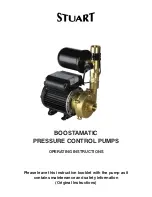
11
AS, IC
GD, GDR
4.3
TRANSPORT AND STORAGE
The pump can be transported in both vertical and horizontal position. It must be firmly anchored in
order not to tip over or roll away.
When handling, hang the pump for the handle only; never stretch the cable by pulling it!! Is possible to
use only approved and undamaged hanger with load capacity higher then weight of pump. In
consideration of pump weight does not recomend to handle of pump by women. Pumps up to 50kg
weight can handle by two men.
Pumps above 50kg weight hang the pump on hanger with suspension strand and use suitable
manipulation device (trolley etc).
When it is freezing, it is necessary to leave the pump submerged in a non-freezing liquid or to pull the pump out and
dry up. Should any left water freeze in the hydraulic enclosure, submerge the pump in a liquid, never use flame to
defrosting.
During a longer storage or operation pause of the pump it is necessary:
•
To make time to time a few revolutions, so that the mechanical seal sealing rings do not get caked (about 1x
per 2 months); in storage longer than 6 months this is necessary;
•
To place the pump in a dry place.
After a longer storage or operation pause of the pump it is necessary to carry out inspections as if before
commissioning.
The pumps can be stored within temperature range from –25°C to +55°C. For a short period not exceeding 24 hours
the pumps can be stored at temperature up to +70°C.
Pump and especially cables don’t expose to direct sun shininng or another sort of damaging radiation for long time.
Structure of rubber and plastic parts of pump can be damaged.
5.0 CONNECTION TO ELECTRICITY
5.1
GENERALLY
Connection to the power supply and inspection of this connection must be carried out by an expert and
it must comply with national standards and regulations in force. The pump must be properly and safely
grounded. Connection to a switchboard must be equipped with emergency switch!
5.1.1
It is necessary to install following devices for disconnection of power supply:
-
Breakdown switch with or without fuse, according to CSN EN 60947-3 standard, class AC-23B.
-
No-fuse circuit breaker suitable for disconnection according to CSN EN 60947-2 standard
5.1.2
Protective devices for excess current protection:
If no circuit breaker according to the CSN EN 60947-2 is used as a disconnecting device (see 5.1.1), it is
WARNING









































